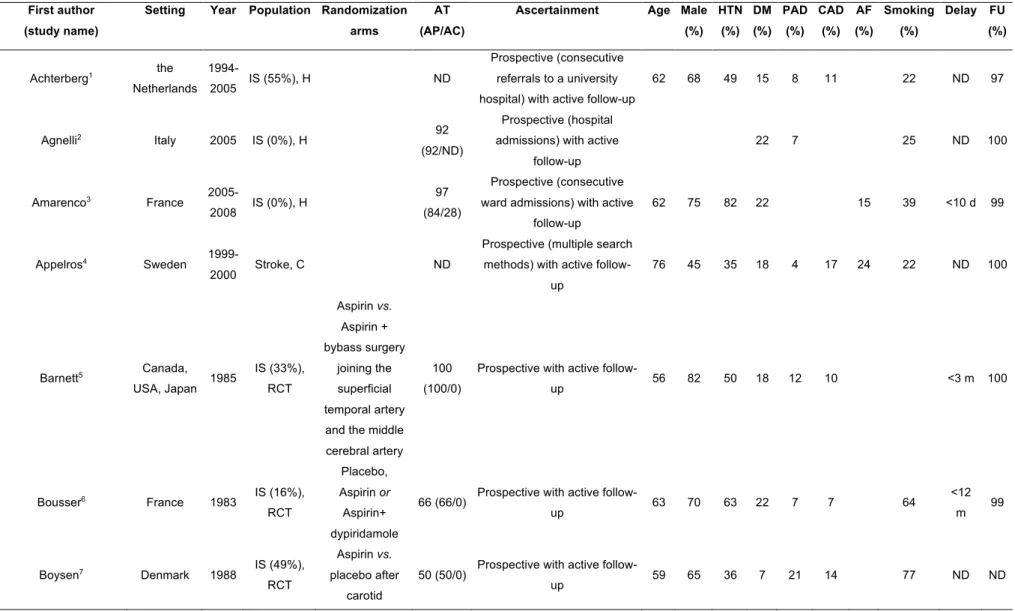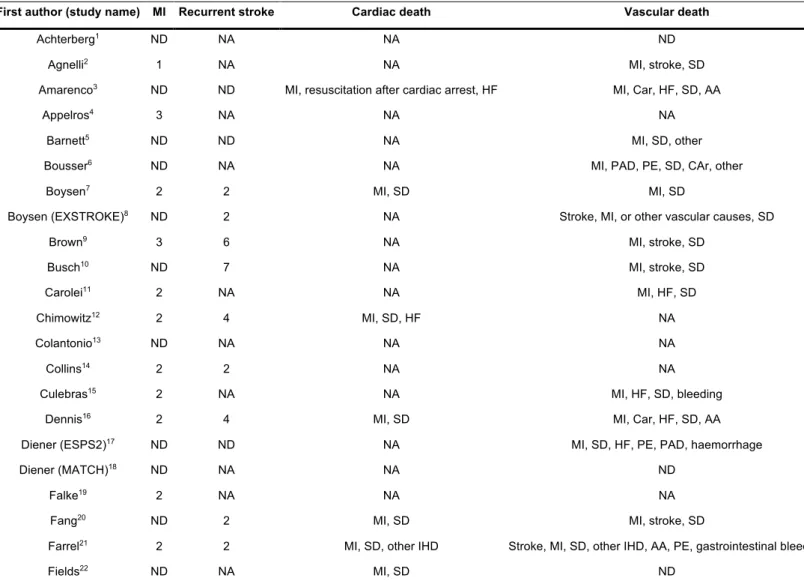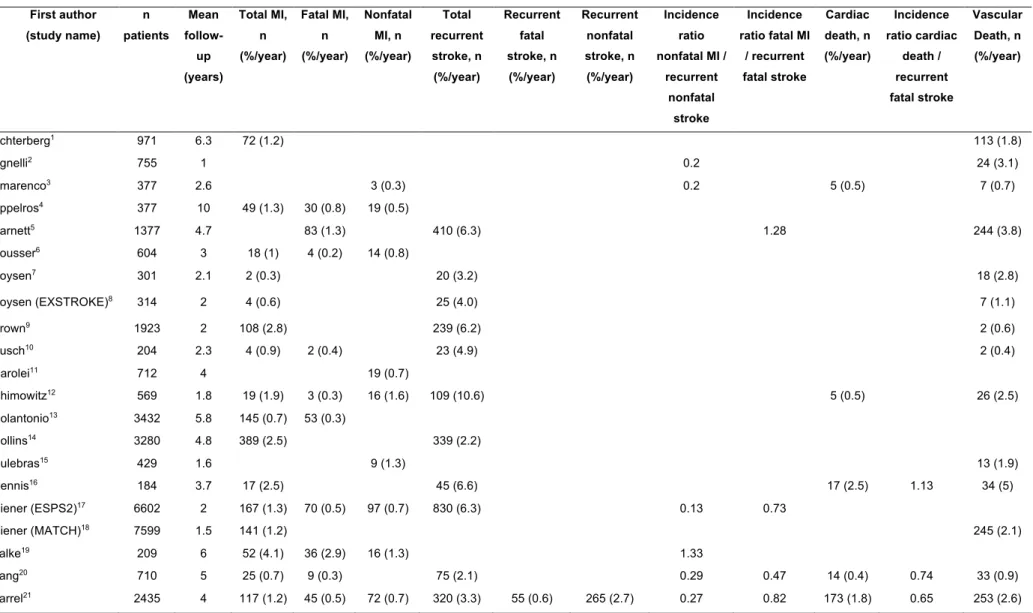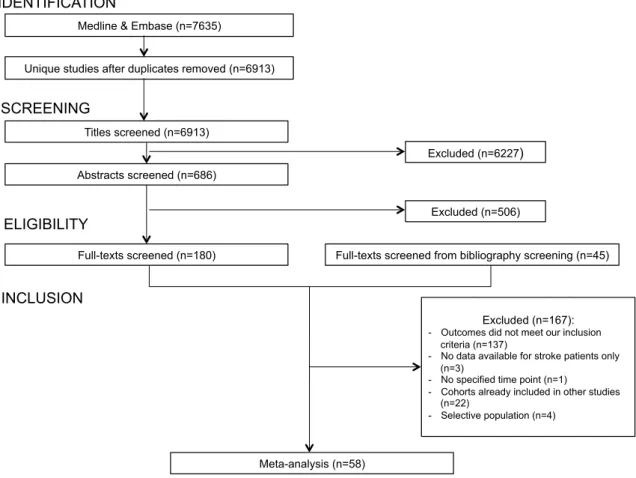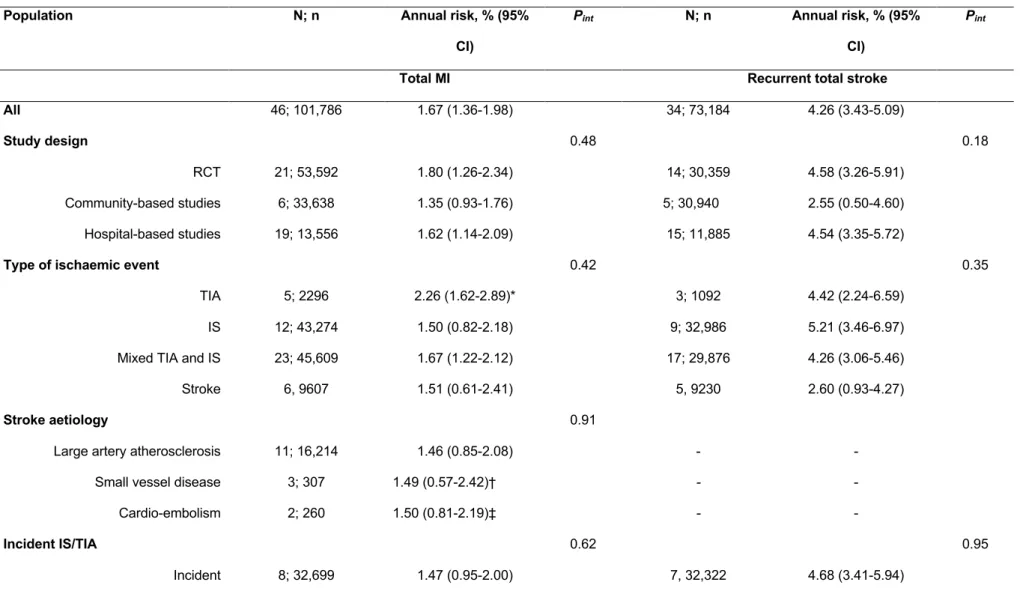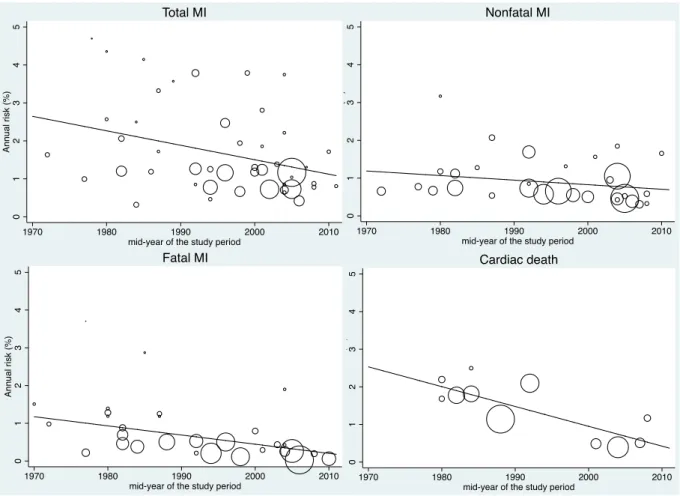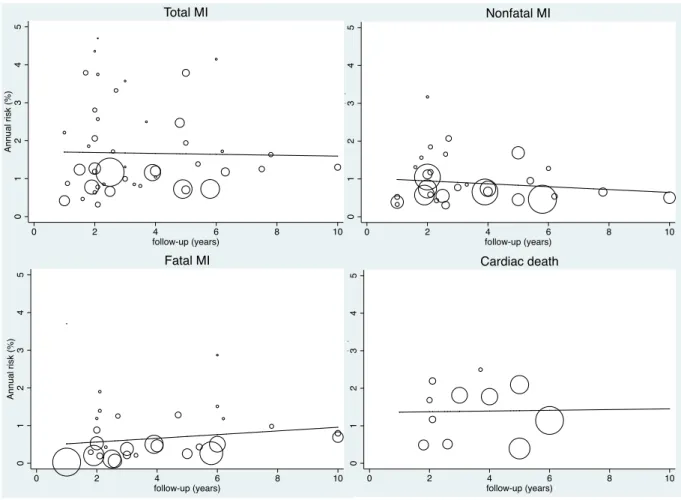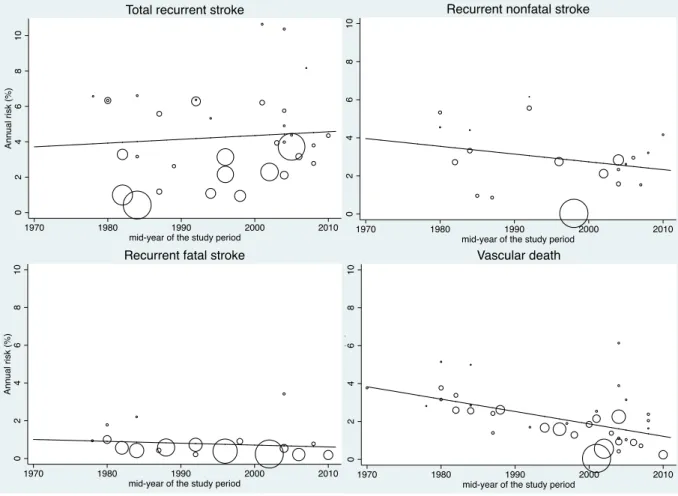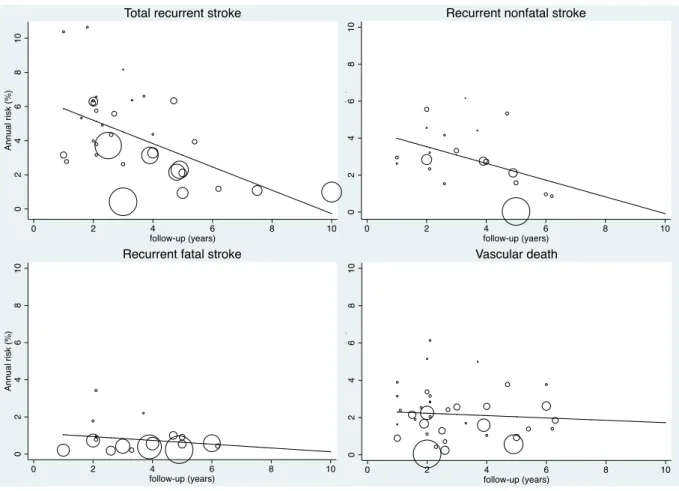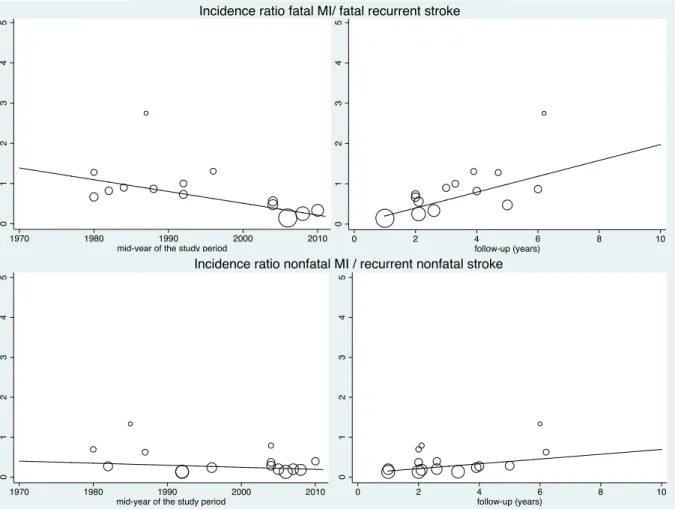HAL Id: tel-03053329
https://tel.archives-ouvertes.fr/tel-03053329
Submitted on 11 Dec 2020HAL is a multi-disciplinary open access
archive for the deposit and dissemination of sci-entific research documents, whether they are pub-lished or not. The documents may come from teaching and research institutions in France or abroad, or from public or private research centers.
L’archive ouverte pluridisciplinaire HAL, est destinée au dépôt et à la diffusion de documents scientifiques de niveau recherche, publiés ou non, émanant des établissements d’enseignement et de recherche français ou étrangers, des laboratoires publics ou privés.
Improving secondary prevention after transient
ischaemic attack (TIA) or ischaemic stroke
Marion Boulanger
To cite this version:
Marion Boulanger. Improving secondary prevention after transient ischaemic attack (TIA) or is-chaemic stroke. Human health and pathology. Normandie Université, 2019. English. �NNT : 2019NORMC416�. �tel-03053329�
Spécialité RECHERCHE CLINIQUE, INNOVATION TECHNOLOGIQUE, SANTE PUBLIQUE
Préparée au sein de l'Université de Caen Normandie
Αméliοratiοn de la préventiοn secοndaire après un infarctus
cérébral οu un accident ischémique transitοire (ΑΙΤ).
Présentée et soutenue par
Marion BOULANGER
Thèse soutenue publiquement le 10/12/2019
devant le jury composé de
M. DAVID CALVET Professeur des universités PraticienHosp, Université Paris 5Descartes Rapporteur du jury M. ARIEL COHEN Professeur des universités PraticienHosp, Université Paris 6Pierre et Marie Curie Rapporteur du jury M. YANNICK BEJOT Professeur des universités PraticienHosp, Hôpital FrançoisMitterrand Membre du jury Mme STEPHANIE DEBETTE Professeur des universités PraticienHosp, Université deBordeaux Membre du jury Mme LYDIA GUITTET Professeur praticien hospitalier, Université Caen Normandie Président du jury M. EMMANUEL TOUZE Professeur des universités, Université Caen Normandie Directeur de thèse M. PETER ROTHWELL Professeur, Université d'Oxford Co-directeur de thèse
Thèse dirigée par EMMANUEL TOUZE et PETER ROTHWELL, Physiopathologie et
imagerie des troubles neurologiques
ACKNOWLEDGEMENTS
Je remercie vivement Emmanuel Touzé, mon directeur de thèse, pour son encadrement, ses conseils, sa rigueur, sa disponibilité et son soutien. Travailler à ses côtés est riche d’enseignements. Je le remercie également pour les futurs travaux à venir, que j’espère, il continuera à me confier !
I am extremelJ grateful to Peter Rothwell, mJ co-supervisor, for welcoming me in the “OXVASC familJ” for nearlJ two Jears and giving me the opportunitJ to work with all his dedicated staff. I would also thank for his advices and guidance in mJ research projects.
Je remercie Ariel Cohen et David Calvet, les rapporteurs de ma thèse, d’avoir accepté de consacrer de leur temps pour examiner ce travail et du privilège qu’ils m’accordent de pouvoir bénéficier de leurs commentaires.
Je remercie Stéphanie Debette d’avoir accepté de participer à mon jurJ de soutenance. C’est un honneur de pouvoir bénéficier de son expertise en neurologie et en épidémiologie pour l’évaluation de ce travail. Je souhaite que nous puissions continuer à collaborer.
Je remercie Yannick Béjot pour son implication dans la revue sJstématique et sa participation au jurJ. Je souhaite que nous puissions continuer à collaborer.
Je remercie LJdia Guittet d’avoir accepté de participer au jurJ et d’apporter ainsi ses compétences en santé publique dans le jugement de ce travail.
Je remercie Denis Vivien et son équipe pour m’avoir accueillie (brièvement) au sein du laboratoire de CJcéron et pour tous les projets en cours et à venir.
I am verJ grateful for the help and support of all the team in OXVASC, especiallJ Linxin Li, Louise Silver, Magdalena Kubiak, Shane LJons, Rob Hurford, Aravind Ganesh, Ian McGurgan, Dearbhla KellJ, Aubretia McColl, GarJ Lau, Maria Tuna, Sara Marzucco, Mirjam Heldner, Nina Hilkens.
I must also thank the friends I met with Oxford CitJ CJcling UK. I will remember the wonderful rides in Oxfordshire and beJond (and, I believe, mJ visit at the A&E department in Bournemouth hospital was part of the experience !). Special thanks to Lana & Quentin !
Enfin, je remercie ma merveilleuse Maman et Philippe.
Un grand merci à Fabien pour les sorties vélo et nage (passées et futures) et, surtout, pour tout le reste !
A mes amis dont je ne peux citer tous les noms.
A Floriane pour le partage des mois studieux et des randonnées (to be continued in Canada!)
Je remercie La Société Française de Neurovasculaire-France AVC, la Société
Française de Neurologie-JNLF, et la Fondation Thérèse et René Planiol pour l’Etude du Cerveau pour le financement de ma thèse.
TABLE OF CONTENTS
TABLE OF CONTENTS
TABLE OF CONTENTS ... 1
TABLE OF TABLES ... 3
TABLE OF FIGURES ... 7
PUBLICATIONS AND PRESENTATIONS ... 9
GENERAL ABSTRACT ... 11
RESUME GENERAL ... 13
INTRODUCTION ... 17
BACKGROUND AND RATIONALE OF THIS THESIS ... 17
OBJECTIVE OF THIS THESIS ... 20
I. CURRENT LONG-TERM PROGNOSIS AFTER TRANSIENT ISCHAEMIC ATTACK (TIA) OR ISCHAEMIC STROKE: ABSOLUTE RISKS OF RECURRENT STROKE AND MYOCARDIAL INFARCTION ... 23
I.1.LONG-TERM RISK OF MYOCARDIAL INFARCTION COMPARED TO RECURRENT STROKE AFTER TRANSIENT ISCHAEMIC ATTACK AND ISCHAEMIC STROKE: SYSTEMATIC REVIEW AND META -ANALYSIS ... 25 Abstract ... 26 Introduction ... 27 Methods ... 28 Results ... 31 Discussion ... 63
I.2.TIME TRENDS (2002-2014) IN THE RISK OF CORONARY EVENTS AND OF RECURRENT ISCHAEMIC STROKE AFTER TIA OR ISCHAEMIC STROKE AT THE POPULATION-LEVEL ... 67
Abstract ... 68
Introduction ... 69
Methods ... 70
Results ... 73
Discussion ... 85
II. IDENTIFICATION OF INDIVIDUALS AT HIGH RISK OF RECURRENT STROKE OR MYOCARDIAL INFARCTION AFTER TIA OR ISCHAEMIC STROKE ... 87
II.1.EFFECT OF COEXISTING VASCULAR DISEASE ON LONG-TERM RISK OF RECURRENT EVENTS AFTER TIA OR STROKE ... 89
Introduction ... 91
Methods ... 93
Results ... 96
Discussion ... 113
II.2.ESSEN RISK SCORE IN PREDICTION OF MYOCARDIAL INFARCTION AFTER TIA OR ISCHAEMIC STROKE WITHOUT PRIOR CORONARY ARTERY DISEASE ... 115
Abstract ... 116
Introduction ... 117
Material and methods ... 119
Results ... 122
Discussion ... 140
II.3.LONG-TERM COST OF MYOCARDIAL INFARCTION DURING FOLLOW-UP AFTER TRANSIENT ISCHAEMIC ATTACK OR ISCHAEMIC STROKE ... 143
Abstract ... 144 Introduction ... 145 Methods ... 146 Results ... 147 Discussion ... 153 GENERAL DISCUSSION ... 155
CONCLUSIONS OF THE THESIS ... 155
IMPLICATIONS FOR FUTURE RESEARCH AND CLINICAL PRACTICE ... 159
REFERENCES ... 165
APPENDICES ... 175
TABLE OF TABLES
TABLE OF TABLES
Table 1 : Characteristics of the included studies in the systematic review ... 32 Table 2 : Definitions of myocardial infarction (MI), recurrent stroke, cardiac and vascular deaths ... 40 Table 3 : Numbers and proportions of studies with definitions of myocardial infarction (MI) . 43 Table 4 : Numbers and proportions of studies with definitions of recurrent stroke ... 43 Table 5 : Risks of myocardial infarction (MI), recurrent stroke, cardiac and vascular deaths in the included studies ... 44 Table 6 : Annual risks of myocardial infarction (MI), recurrent stroke, cardiac and vascular deaths in subgroups analyses ... 48 Table 7 : Baseline characteristics in TIA or ischaemic stroke patients, based on study periods in OXVASC (2002-2014) ... 74 Table 8 : Time trend in the absolute risk of coronary events in patients with TIA or ischaemic stroke (2002-2014) ... 77 Table 9 : Time trend in the absolute risk of recurrent ischaemic stroke in patients with TIA or ischaemic stroke (2002-2014) ... 78 Table 10 : Comparison of the risk of coronary events and of recurrent ischaemic stroke over the three study periods in OXVASC ... 81 Table 11 : Relative effects of risk factors for coronary events after TIA or ischaemic stroke according to the study period in OXVASC ... 83 Table 12 : Relative effects of risk factors for recurrent ischaemic stroke after TIA or
ischaemic stroke according to the study period in OXVASC ... 84 Table 13 : Baseline characteristics in TIA or ischaemic stroke patients, stratified by history of co-existing cardiovascular disease ... 97 Table 14 : Baseline characteristics in TIA or ischaemic stroke patients stratified by
TIA/ischaemic stroke subtypes (TOAST classification) ... 99 Table 15: Baseline characteristics of patients with non-cardioembolic TIA or ischaemic stroke and after exclusion of those on anticoagulants, stratified by history of co-existing
cardiovascular disease ... 100 Table 16 : 10-year risk of coronary events, recurrent ischaemic stroke, major ischaemic vascular events, intracerebral haemorrhage and major extracranial bleeds after
TIA/ischaemic stroke in patients with versus without co-existing cardiovascular disease, stratified by age ... 102
vascular events, intracerebral haemorrhage and major extracranial bleeds after TIA or ischaemic stroke patients, stratified by stroke subtype ... 109 Table 18 : 10-year risk of coronary events, recurrent ischaemic stroke, major ischaemic vascular events, intracerebral haemorrhage and major extracranial bleeds in the subgroup of patients with TIA or ischaemic stroke due to large artery disease (TOAST classification), stratified by baseline history of co-existing cardiovascular disease ... 111 Table 19 : The Essen risk score11,13 ... 121 Table 20 : Baseline characteristics in TIA or ischaemic stroke patients included in the
analysis and medication at baseline and on follow-up ... 123 Table 21 : 10-year risks of myocardial infarction and recurrent ischaemic stroke after TIA or ischaemic stroke in patients without prior coronary artery disease (CAD), stratified by the Essen risk score, and in those with prior CAD ... 125 Table 22 : Variables of the Essen score and risk of myocardial infarction in TIA/ischaemic stroke patients without prior coronary artery disease ... 127 Table 23 : Stratification by Essen score of ≥4 versus <4 and risk of myocardial infarction and of recurrent ischaemic stroke in TIA/ischaemic stroke patients without prior coronary artery disease ... 129 Table 24 : Stratification by Essen score of ≥4 versus <4 and risk of myocardial infarction and of recurrent ischaemic stroke in TIA/ischaemic stroke patients without prior coronary artery disease, stratified by TIA/ischaemic stroke subtype (TOAST classification) ... 130 Table 25: 10-year risk of myocardial infarction or recurrent ischaemic stroke after TIA or ischaemic stroke based on presence of large artery disease (TOAST) subtype in patients without prior coronary artery disease (CAD), stratified by the Essen risk score, and in those with prior CAD ... 133 Table 26 : Association between TIA/ischaemic stroke subtype (TOAST classification) and risk of myocardial infarction and of recurrent ischaemic stroke in TIA or recurrent ischaemic stroke patients without prior coronary artery disease ... 134 Table 27 : 10-year risk of myocardial infarction and of recurrent ischaemic stroke after TIA or ischaemic stroke in patients without prior coronary artery disease (CAD), stratified by the modified Essen risk score (after adding the variable “presence of large artery disease
TIA/Stroke subtype” to the score), and in those with prior CAD ... 135 Table 28 : Stratification by modified Essen score (after adding the variable “presence of large artery disease subtype” to the score) of ≥4 versus <4 and risk of myocardial infarction and of recurrent ischaemic stroke in TIA/ischaemic stroke patients without prior coronary artery disease ... 136
TABLE OF TABLES
Table 29 : Characteristics of the seven TIA or ischaemic stroke patients who experienced a myocardial infarction (MI) during follow-up after withdrawal of antithrombotic therapy ... 138 Table 30 : Baseline characteristics in TIA or ischaemic stroke patients ... 147 Table 31 : Costs of myocardial infarction (MI) for all 118 TIA or ischaemic stroke patients with a follow-up MI ... 149 Table 32 : 10-year cost of myocardial infarction (MI) averaged across all TIA or ischaemic stroke patients ... 151 Table 33 : 10-year risk of follow-up myocardial infarction in TIA or ischaemic stroke patients determined by Kaplan-Meier method, based on baseline clinical characteristics ... 152
TABLE OF FIGURES
TABLE OF FIGURES
Figure 1 : PRISMA Flow diagram describing identification, screening, eligibility, and inclusion of studies in the systematic review ... 47 Figure 2 : Evolution of the annual risks of myocardial infarction (MI) and cardiac death in TIA or ischaemic stroke patients over time ... 53 Figure 3 : Evolution of the annual risks of myocardial infarction (MI) and cardiac death in TIA or ischaemic stroke patients with the duration of study’s follow-up ... 55 Figure 4 : Evolution of the annual risks of recurrent stroke and vascular death in TIA or ischaemic stroke patients over time ... 56 Figure 5 : Evolution of the annual risks of recurrent stroke and vascular death in TIA or ischaemic stroke patients with the duration of study’s follow-up ... 57 Figure 6 : Evolution of the incidence ratio of fatal and nonfatal myocardial infarction (MI) / recurrent stroke over time and with the duration of study’s follow-up ... 60 Figure 7 : Evolution of the incidence ratio of cardiac death / recurrent fatal stroke against study’s duration follow-up and over time ... 61 Figure 8 : Forest plots of the meta-analyses of potential risk factors for myocardial infarction (MI) in TIA or ischaemic stroke patients ... 62 Figure 9: Time trend in the risk of coronary events and of recurrent ischaemic stroke after TIA or ischaemic stroke for 2002-2014 ... 79 Figure 10 : Risks of coronary events, recurrent ischaemic stroke, major ischaemic vascular events and major bleeds after TIA or ischaemic stroke, stratified by history of co-existing cardiovascular disease ... 104 Figure 11 : Risk of coronary events after TIA or ischaemic stroke, stratified by history of coronary (CAD), peripheral artery disease (PAD) or age ... 105 Figure 12 : 5 year-risk of coronary events in TIA or ischaemic stroke patients with and
without history of coronary artery disease, stratified by number of atherosclerotic risk factors, history of diabetes, history of peripheral artery disease (PAD) or TIA/ischaemic stroke
subtype ... 106 Figure 13 : Risk of recurrent ischaemic strokes in TIA or ischaemic stroke patients stratified by history of coronary (CAD), peripheral artery disease (PAD) or age ... 107 Figure 14 : Risks of coronary events and recurrent ischaemic stroke after TIA or ischaemic stroke, stratified by stroke subtype (TOAST classification) ... 110 Figure 15 : Risks of coronary events, recurrent ischaemic stroke, major ischaemic vascular events and major bleeds after TIA or ischaemic stroke due to large artery disease (TOAST classification), stratified by history of co-existing cardiovascular disease ... 112
TIA or ischaemic stroke patients based on presence of prior coronary artery disease (CAD) and the Essen score ... 126 Figure 17 : Risk of myocardial infarction in TIA or ischaemic stroke patients stratified by history of presence of prior coronary artery disease ... 131 Figure 18 : Risk of recurrent ischaemic strokes in TIA or ischaemic stroke patients stratified by presence of prior coronary artery disease ... 132
PUBLICATIONS AND PRESENTATIONS
PUBLICATIONS AND PRESENTATIONS
The work in this thesis has led to the following publications and presentations:
Publications
Boulanger M, Béjot Y, Rothwell PM, Touzé E. Long-term risk of myocardial infarction compared to recurrent stroke after transient ischaemic attack and ischaemic stroke: systematic review and meta-analysis. J Am Heart Assoc.2018 Jan 18;7:e007267. DOI: 10.1161/JAHA.117.007267
Boulanger M, Li L, Lyons L, Lovett NG, Kubiak MM, Silver L, Touzé E, Rothwell PM on behalf of the Oxford Vascular Study. Effect of coexisting vascular disease on long-term risk of recurrent events after TIA or stroke. Neurology.2019; 93:e1-e13.
doi:10.1212/WNL.0000000000007935
Boulanger M, Li L, Lyons L, Lovett NG, Kubiak MM, Silver L, Touzé E, Rothwell PM on behalf of the Oxford Vascular Study. Essen risk score in prediction of myocardial infarction after TIA or ischaemic stroke without prior coronary artery disease. Stroke (accepted)
Luengo-Fernandez R*, Boulanger M*, Lukha R, Li L, Lyons L, Lovett NG, Kubiak MM, Silver L, Touzé E, Rothwell PM on behalf of the Oxford Vascular Study. Long-term cost of
myocardial infarction during follow-up after transient ischaemic attack or ischaemic stroke. Heart (under review)
*equal contribution
Presentations
Boulanger M, Li L, Silver L, Touzé E, Rothwell PM.Subgroups of TIA and ischaemic stroke patients with a high residual risk of coronary events: population-based cohort study
Presented for the European Stroke Organisation Conference 2018
Boulanger M, Li L, Lyons L, Lovett NG, Kubiak MM, Silver L, Touzé E, Rothwell PM on behalf of the Oxford Vascular Study. Effect of coexisting vascular disease on long-term risk of recurrent events after TIA or stroke: prospective population-based cohort
Touzé E, Rothwell PM on behalf of the Oxford Vascular Study. Long-term cost of myocardial infarction during follow-up after transient ischaemic attack or ischaemic stroke.
Presented for the European Stroke Organisation Conference 2019
Boulanger M, Li L, Touzé E, Rothwell PM. Risque d’évènement coronarien, récurrence d’infarctus cérébral et saignement majeur après infarctus cérébral ou AIT selon la présence de maladie vasculaire concomitante
Presented for the Journées de la Société Francaise de Neurovasculaire 2018
Book chapters
Chapitre sur la prise en charge aigue d’un infarctus cérébral et d’une hémorragie cérébrale pour l’ouvrage collectif Principes et protocoles en neuro-anesthésie-réanimation, coordonné par C. Gakuba et F. Verdonk (2019) à destinée des réanimateurs et urgentistes prenant en charge des patients avec un AVC
Chapitre sur la lecture critique des essais thérapeutiques de phase aiguë et de prévention secondaire pour l’ouvrage collectif Thérapeutique des AVC, coordonné par J.-L. Mas et D. Leys (2018), à destinée des neurologues et tous médecins prenant en charge des patients avec un AVC
Chapitre sur la dysplasie musculaire comme causes rares d’AVC pour l’ouvrage collectif Thérapeutique des AVC, coordonné par J.-L. Mas et D. Leys (2018)
GENERAL ABSTRACT
GENERAL ABSTRACT Background.
The current long-term prognosis after transient ischaemic attack (TIA) or ischaemic stroke is not well known. Previous studies suggest that TIA/ischaemic stroke patients are at substantial risk of long-term recurrent stroke and cardiac events despite secondary prevention management; and that the cause of death after TIA/ischaemic stroke is more often due to coronary events than to recurrent stroke. However, secondary prevention has improved over time and whether absolute risks and high-risk subgroups of patients on current care remain the same as those previously identified is uncertain. Therefore, I aimed to (1) determine the current long-term absolute risks of recurrent stroke and coronary events after TIA or ischaemic stroke and (2) identify individuals who remain at high absolute risk of recurrent ischaemic events despite current secondary prevention management.
Methods and main findings
In a systematic review and meta-analysis of long-term follow-up of studies of TIA or ischaemic stroke patients to determine the risk of myocardial infarction and recurrent stroke after TIA/ischaemic stroke, we showed that the risk of death due to myocardial infarction was not higher than the risk of death due to recurrent ischaemic stroke. The risk of myocardial infarction after TIA/ischaemic stroke has significantly decreased over time since 1970s while the risk of recurrent stroke has not.
In a population-based cohort of consecutive TIA or ischaemic stroke patients in Oxfordshire, UK (Oxford Vascular study, OXVASC) recruited from 2002 to 2014 (n=2,555), the current overall 10-year absolute risk of recurrent ischaemic stroke was 25.3% (95%CI 22.6-27.8) and the 10-year risk of coronary events was 10.6% (95%CI 8.8-12.4). For 2002-2014, the risks of recurrent ischaemic stroke and coronary events have significantly decreased over time. These time trends were independent of any change in vascular risk factors over the study period. TIA/ischaemic stroke patients with co-existing cardiovascular disease, i.e. history of prior coronary or peripheral artery disease, (n=640; 25.0%) were at significantly increased risk of recurrent ischaemic stroke than those without (10-year risk=31.5%, 95%CI 25.1-37.4; versus 23.4%, 20.5-26.3; p=0.0049) and coronary events (10-year risk=22.8%, 17.4-27.9; versus 7.1%, 5.3-8.8; p<0.001).
Then, I determined whether the Essen risk score, which is a simple clinical score to predict the 1-year risk of recurrent ischaemic stroke, identified a subset of patients without prior coronary artery disease who had nevertheless a high risk of myocardial infarction despite current secondary prevention management. The 10-year risk of myocardial infarction in TIA/ischaemic stroke patients without prior coronary artery disease (n=2017; 78.9%) ranged from 0.9%
(0-0.57-0.71, p<0.001). Among TIA/ischaemic stroke patients without prior coronary artery disease, those with an Essen score of ³4 (n=294; 11.5%) were at similarly high 10-year risk of myocardial infarction as patients with prior coronary artery disease (17.2%, 6.9-26.3; versus 16.9%, 11.5-22.0) and of recurrent ischaemic stroke (40.4%, 26.7-51.6; versus 32.4%, 25.2-38.8). Among patients with non-cardioembolic TIA/ischaemic stroke and after exclusion of those on anticoagulants (i.e. on antiplatelet therapy for secondary prevention), the 10-year risk of major extracranial bleeds was high in patients with prior coronary artery disease (12.5%, 6.1-18.4) and in those without prior coronary artery disease and with an Essen score of ³4 (20.7%, 0-37.9).
Eventually, I determined the cost of myocardial infarction after TIA/ischaemic stroke and the likely long-term myocardial infarction-related cost saving from routine co-prescription with new lipid-lowering therapies, PCSK-9 inhibitors, for secondary prevention. The total mean (SD) cost of myocardial infarction was $9182 (12,757). The 10-year mean cost of myocardial infarction averaged across all patients was $424 (95%CI 333-525) per patient. The corresponding costs of routine life-long co-prescription of PCSK-9 inhibitors were $34,767 (33,968-35,679) per patient. Myocardial infarction treatment costs were higher in those with prior coronary ($787 per patient, 493-1151; versus. $326, 234-434, p=0.009) or peripheral artery disease ($893 per patient, 440-1472; versus $386, 288-496, p=0.05). Cost of routine co-prescription of PCSK9-inhibitors remained over $24,000 per patient in the subgroups at higher risk of myocardial infarction.
Discussion and perspectives
The overall absolute risks of recurrent ischaemic stroke and coronary events after TIA/ischaemic stroke have decreased over the last decade, and are likely to be explained by the improvement of secondary prevention over time. However, despite current secondary prevention, the subgroups of TIA/ischaemic stroke patients with prior coronary disease and those without prior coronary disease and with an Essen score of ³4 remain at sufficiently high absolute risk of recurrent ischaemic events to justify more intensive treatment.
Compared to current secondary prevention therapies, future secondary prevention therapies would need to achieve a substantial absolute risk reduction to outweigh increased side effects or cost. Thus, in these high-risk subgroups, more intensive lipid-lowering therapies, in addition to statins, might be justified, but the total cost of with PCSK-9 inhibitors seems to exceed the generally accepted cost-effectiveness threshold while benefit from increased antithrombotic treatment might be offset by the higher risk of extracranial bleeding.
RESUME GENERAL
RESUME GENERAL
Contexte.
Le pronostic à long-terme actuel après un accident ischémique transitoire (AIT) ou un accident vasculaire cérébral ischémique (AVCi, i.e. un infarctus cérébral) reste mal connu. Des études anciennes suggèrent que les patients ayant eu un AIT ou un infarctus cérébral sont exposés à un risque significatif à long-terme de récidive d’infarctus cérébral et
d’évènement coronarien aigu malgré le traitement de prévention secondaire, et que la cause de décès après un AIT/infarctus cérébral serait plus fréquemment due à un d’évènement coronarien aigu qu’à une récidive d’infarctus cérébral. Cependant, la prévention secondaire après un AIT ou un infarctus cérébral s’est améliorée au cours du temps et si les risques absolus et les sous-groupes de patients considérés à haut risque de récidive sous traitement actuel sont les mêmes que ceux identifiés antérieurement reste incertain. Ainsi, j’ai (1) déterminé les risques absolus actuels à long-terme de récidive d’infarctus cérébral et d’évènement coronarien aigu après un AIT ou un infarctus cérébral et (2) identifié les individus qui restent à haut risque absolu de récidive ischémique malgré la prévention secondaire actuelle.
Méthodes et principaux résultats
J’ai d’abord réalisé une revue systématique et une méta-analyse des études incluant des patients ayant eu un AIT ou un infarctus cérébral avec un suivi à long-terme pour déterminer le risque d’infarctus du myocarde et de récidive d’AVC après un AIT/infarctus cérébral. Le risque de décès dû à un infarctus du myocarde n’était pas augmenté par rapport au risque de décès dû à une récidive d’AVC. Le risque d’infarctus du myocarde après un AIT/infarctus cérébral a significativement diminué au cours du temps depuis les années 1970 tandis que le risque de récidive d’AVC n’a pas évolué significativement au cours du temps. Cependant, peu d’études ont recruté des patients après les années 2000 et la prévention secondaire après un AIT/infarctus cérébral s’est amélioré dans les dernières décennies, notamment avec l’utilisation de dose plus élevée de statines et un meilleur contrôle de la pression artérielle.
Dans une cohorte populationnelle contemporaine de patients consécutifs ayant eu un AIT ou un infarctus cérébral (Oxford Vascular study, OXVASC) entre 2002 et 2014 (n=2225), le risque absolu à 10ans de récidive d’infarctus cérébral était de 25.3% (IC95% 22.6-27.8) et le risque à 10ans d’évènement coronarien aigu était de 10.6% (IC95% 8.8-12.4). Entre 2002 et 2014, les risques de récidive d’infarctus cérébral et d’évènement coronaire aigu ont
période d’étude.
Ensuite, j’ai déterminé si les sous-groupes de patients ayant eu un AIT/infarctus cérébral avec une pathologie cardiovasculaire associée (i.e. un antécédent de pathologie
coronarienne ou ischémique des membres inférieures) étaient toujours à haut risque résiduel de récidive d’évènements ischémique malgré la prise en charge actuelle, et pourraient bénéficier d’une prévention secondaire plus intensive. Les patients avec une pathologie cardiovasculaire associée (n=640; 25.0%) avaient un risque significativement plus élevé de récidive d’infarctus cérébral comparés aux patients sans pathologie cardiovasculaire associée (risque à 10ans=31.5%, IC95% 25.1-37.4; versus 23.4%, 20.5-26.3; p=0.0049) et d’évènement coronarien aigu (risque à 10ans =22.8%, 17.4-27.9; versus 7.1%, 5.3-8.8; p<0.001).
Ensuite, j’ai déterminé si le score Essen, qui est un score clinique simple pour prédire le risque de récidive d’infarctus cérébral à 1an, permettait d’identifier un sous-groupe de patients sans antécédent de pathologie coronarienne qui était néanmoins à haut risque d’infarctus du myocarde malgré la prévention secondaire actuelle. Le risque à 10ans d’infarctus du myocarde chez les patients sans antécédent de pathologie coronarienne (n=2017; 78.9%) variait de 0.9% (0-1.9) pour un score Essen £1 à 29.8% (7.7-46.6) pour un score ³5 (c-statistic=0.6, IC95% 0.57-0.71, p<0.001). Parmi les patients sans antécédent de pathologie coronarienne, ceux avec un score Essen ³4 (11.5%) avaient un risque absolu à 10ans d’infarctus du myocarde comparable aux patients avec un antécédent de pathologie coronaire (17.2% versus 16.9%) et de récidive d’infarctus cérébral (40.4% versus 32.4%). Parmi les patients ayant eu un AIT/infarctus cérébral d’étiologie non cardioembolique et après exclusion des patients sous anticoagulants (i.e. sous traitement antiplaquettaire en prévention secondaire), le risque à 10ans d’hémorragie extracrânienne majeure était élevé chez les patients avec un antécédent de pathologie coronaire (12.5%, 6.1-18.4) et chez ceux sans antécédent de pathologie coronaire et avec un score Essen ³4 (20.7%, 0-37.9).
Enfin, j’ai déterminé le coût moyen de la prise en charge d’un infarctus du myocarde à 10ans après un AIT/infarctus cérébral et calculé la potentielle réduction du coût liée à la co-prescription systématique en prévention secondaire d’un nouveau traitement hypocholestérolémiant ayant montré une réduction significative du risque d’infarctus du myocarde, les inhibiteurs de la PCSK-9, en association avec les statines. Le coût moyen de la prise en charge d’un infarctus du myocarde à 10ans après AIT/infarctus cérébral était de 424$ (IC95% 333-525) par patient. Le coût moyen de la co-prescription systématique d’un inhibiteur de la PCSK-9 à 10ans après un AIT/infarctus cérébral était de 34767$ (33968-35679) par patient. Le coût moyen de la prise en charge d’un infarctus du myocarde à 10ans était
RESUME GENERAL
significativement plus élevé chez les patients avec un antécédent de cardiopathie ischémique (787$ par patient, 493-1151; versus 326$ par patient, 234-434, p=0.009) ou une artérite des membres inférieurs (893$ par patient, 440-1472; versus 386$ par patient, 288-496, p=0.05), du fait de leur risque d’infarctus du myocarde augmenté plutôt que d’un coût de traitement plus élevé. Chez ces sous-groupes de patients à haut risque, le coût moyen de la co-prescription systématique d’un inhibiteur de la PCSK-9 à 10ans restait >24000$ par patient.
Discussion et perspectives.
Les risques absolus de récidive d’infarctus cérébral et d’infarctus du myocarde après un AIT/infarctus cérébral ont significativement diminué au cours des dernières décennies, très probablement du fait de l’amélioration de la prévention secondaire avec le temps. Cependant, malgré la prévention secondaire actuelle les sous-groupes de patients ayant eu un AIT/infarctus cérébral avec un antécédent de pathologie coronarienne et ceux sans antécédent coronaire et avec un score Essen ³4 restent à un risque absolu de récidive d’évènement ischémique suffisamment élevé pour justifier d’une intensification du traitement. Par rapport aux thérapeutiques de prévention secondaire actuelles, les thérapeutiques de prévention secondaire futures nécessitent de permettre d’obtenir une réduction absolue du risque de récidive d’évènement ischémique suffisante pour compenser un risque augmenté d’effets indésirables ou de surcoût. Chez ces sous-groupes de patients à haut risque de récidive ischémique, une réduction plus intensive du taux de cholestérol avec les inhibiteurs des PCSK-9, en association avec les statines, parait tout à fait justifiée, cependant le coût de ces traitements semble excéder la limite du rapport coût-efficacité généralement accepté tandis que le bénéfice d’une majoration du traitement antithrombotique semble contrebalancé par l’augmentation du risque hémorragique extracrânien.
INTRODUCTION
INTRODUCTION
Background and rationale of this thesis
Stroke corresponds to “rapidly developing clinical signs of focal disturbance of cerebral function of vascular origin”,1 85% of strokes are ischaemic and 15% are haemorrhagic.
Worldwide, stroke is the second cause of dementia, after Alzheimer’s disease, and the second cause of mortality, after ischaemic heart disease.2, 3 Noteworthy, stroke has remained the top
two cause of death worldwide since 1990, although the absolute number of deaths due to stroke has increased by 26% between 1990 and 2013.3 Stroke is also the third most common
cause of disability in the world, being the first cause of acquired disability in adults,3 and the proportional contribution of stroke-related disability and deaths due to stroke, compared with all diseases, is increasing.3 Worldwide, although the mortality due to stroke has decreased
over time, the absolute number of people with a stroke and the stroke-related burden of stroke, is increasing.3, 4 The lifetime risk of stroke for adults (25 years of age and older) is substantial
and was estimated to be approximately 25% in men and in women in 2016.5 Importantly, 90%
of the global burden of stroke is attributable to modifiable risk factors, including unhealthy diet, tobacco smoking and metabolic factors (diabetes mellitus, hyperlipidaemia and high body mass index),6 highlighting the need to achieve a better control of these risk factors. Despite
the decrease in the age-specific incidence of stroke in the high-income countries, the global burden of stroke is projected to increase in the next decades due to the ageing population and the worldwide rise in the prevalence of diabetes mellitus and obesity, especially in young adults.7, 8 Improvement of stroke prevention appears therefore essential.
Ischemic stroke and transient ischaemic attack (TIA) represent 85% of all strokes and are caused by an episode of neurologic dysfunction due to focal brain, spinal cord or retinal ischemia.1 The global burden of ischaemic stroke has increased over time, with a 37% increase
in the number of people with incident ischaemic stroke and a 18% increase in the ischaemic stroke-related disability between 1990 and 2010.9 The prevalence of ischaemic stroke in 2013,
was 18.3 millions cases (8.7 millions in women and 9.6 millions in men), of whom 7.3 millions (40%) were adults aged less than 65 years.3 Conventionally, a TIA is distinguished from an
ischaemic stroke on the basis of an arbitrary 24-hour cut-off for resolution of symptoms. Hence, a TIA is defined as an acute loss of focal brain or monocular function with symptoms lasting less than 24 hours and which is thought to be caused by inadequate cerebral or ocular blood supply as a result of arterial thrombosis, low flow or embolism associated with arterial, cardiac or hematological disease.10 The recent definition considers TIA as a transient episode of
infarction on brain imaging.11 The issue with this latest definition is that distinction between TIA
and ischaemic stroke very much depends on the type and the timing of the imaging performed. Computerized tomography (CT) scan has less sensitivity to brain infarction than magnetic resonance imaging (MRI) scan, especially in the first few hours, and small infarcts can be missed even at the later phase.12 On the other hand, although MR scan can detect brain
infarcts in the very acute stage of symptoms onset, the sensitivity may remain limited for small infarction, especially in the brain stem. Also, in some parts of the world (in less developed countries or in more rural part of developed countries), acute imaging is not available in clinical practice, which may well limit the generalizability of this tissue-based definition of TIA. Additionally, previous epidemiological studies reporting incidence, prevalence and prognosis of TIA or ischaemic stroke used the time-based definition of TIA and keeping the same definition over time will ease comparison of estimates between cohorts. In this thesis, I therefore used the conventional definition of TIA based on symptoms or signs lasting less than 24 hours.
The current short-term prognosis after ischaemic stroke remains poor, with 30-day mortality estimated to be 20% worldwide,9 while the longer-term outcome is also impaired, even in high
income countries. Among TIA or ischaemic stroke survivors treated according to contemporary guidelines in the UK, approximately a third requires some help for daily activities at 3 months and 1 year,13 while a quarter developed dementia within 1 year after TIA/ischaemic stroke, with
the incidence of dementia being 10 times higher than in non-stroke population.14 Additionally,
patients commonly suffer from psychological disorders after TIA or ischaemic stroke, that also contribute to a reduction in their independence. Stroke-related disabilities have major economic and social impacts for ischaemic stroke patients, as well as for caregivers or patients ‘family, with less than half of the patients returning to work after the ischaemic stroke,15 even
among young patients.16 In addition, despite secondary prevention management, patients are
exposed to long-term disability and morbidity,17 even those with less severe stroke. Indeed,
the long-term mortality after TIA and minor ischaemic stroke is higher than in people without a stroke.18 Also, recent data from the TIA registry show that TIA patients are at substantial risk
of recurrent ischaemic events, with a risk of recurrent stroke or TIA of 17% and of coronary events of 3% at 5 years.19 However, this registry only involved patients who were managed in
specialized centres with secondary prevention care initiated early after the TIA, that may well have underestimated the absolute risk of recurrent ischaemic events in clinical practice. It should not be surprising, therefore, that stroke represents a significant burden on healthcare systems. In the European Union, the total cost of stroke was estimated to be €45 billion in
INTRODUCTION
2015, of which €20 billion were due to direct healthcare costs and €25 billion were due to indirect costs related to lost productivity caused by stroke morbidity or death.20 In high-income
countries, in addition to the high cost of the initial management of acute TIA or ischaemic stroke, the healthcare cost substantially increases within the year post stroke, with cost being at least doubled.21, 22
Previous follow-up studies of patients with incident ischaemic stroke suggest that although recurrent strokes occur more commonly than cardiac events, cardiac events might account for a greater proportion of death than recurrent stroke, despite patients after ischaemic stroke being on secondary prevention management with antithrombotic therapy that lowers risk of both recurrent ischaemic stroke and myocardial infarction.23-27 Guidelines recommend
coronary revascularization for symptomatic coronary artery disease patients to prevent the occurrence of myocardial infarction whereas revascularization for asymptomatic coronary artery disease patients are thought to be less beneficial. However, the prevalence of abnormal myocardial perfusion imaging results in TIA or ischaemic stroke patients with no symptoms suggestive of myocardial ischemia is not uncommon and estimated to be around 30%.28-32
Hence, whether selective screening for asymptomatic coronary artery disease could reduce mortality after TIA/ischaemic stroke remains uncertain, mainly because there are few reliable tools to identify TIA/ischaemic stroke patients at high risk of coronary events. Also, long-term estimates on the risk of coronary events or recurrent ischaemic stroke after TIA/ischaemic stroke are scare and risk factors for myocardial infarction in TIA/ischaemic stroke patients are not well understood. Indeed, whether traditional vascular risk factors, such as history of hypertension or diabetes mellitus, remain good predictors of long-term coronary events after TIA/ischaemic stroke is unclear because such factors are highly prevalent in TIA/ischaemic stroke patients and most of these factors are being controlled with secondary prevention management. There are also no reliable data on coronary risk according to TIA/ischaemic stroke subtype. Unlike coronary disease, TIA or ischaemic stroke is a heterogeneous disease with more than 150 known causes, and the prognosis after TIA or ischaemic stroke varies according to stroke aetiology and presence of vascular risk factors33 and whether
TIA/ischaemic stroke patients at high risk of coronary events are the same as those at high risk of recurrent ischaemic stroke is unknown.
Over the last 15 years, trials of secondary prevention in TIA/ischaemic stroke patients, in particular those of further decrease of blood pressure levels targets34 and of the use of higher
dose of statins,17 have reported significant reduction in the risk of recurrent ischaemic events. However, the impact of these changes on the prognosis of TIA/ischaemic stroke patients
secondary prevention over the last 15 years, as reported in trials, has led to a decrease in the risk of recurrent ischaemic events at the population-level is uncertain. Also, if the prognosis of TIA/ischaemic stroke has improved over time, whether this improvement remained beyond the first months after the TIA/ischaemic stroke is unknown. Assessing the impact of changes in secondary prevention on the prognosis of TIA/ischaemic stroke patients at the population level is required to allow future strategies in TIA/ischaemic stroke care to be implemented appropriately.
Trials of more intensive secondary prevention with new cholesterol lowering therapies, protein subtilisin-kexin type 9 (PCSK-9) inhibitors, have recently reported significant reduction in the risk of coronary events in patients with stable atherosclerotic disease (80% of whom having history of coronary artery disease) treated with high dose of statin,35-37 but relative reduction is modest (between 13% and 27%) and treatment is costly.38 Still in patients with atherosclerotic
disease, a recent trial reported a significant reduction in the risk of ischaemic stroke with the combination of an anticoagulant and an antiplatelet therapy compared to an antiplatelet therapy alone.39 However, there was also an increased risk of major bleeding with the
combination of treatment.39 These findings show that the improvement of secondary
prevention is still achievable, although it also seems necessary to identify individuals at higher absolute risk of recurrent ischaemic events, in whom the potential benefit of these second-line therapies to reduce risk of recurrent ischaemic events might outweigh the risk of side-effects or increased cost. Indeed, a secondary prevention treatment with a large relative risk reduction effect would still have a small overall impact if the absolute risk of recurrent event is low. The subgroup of TIA/ischaemic stroke patients with co-existing stable atherosclerotic cardiovascular disease (coronary or peripheral artery disease) have been shown previously to be at high absolute risk of recurrent stroke and coronary events.40-42 However, whether
high-risk subgroups in TIA/ischaemic stroke patients on current management remain the same as those estimated in older studies is uncertain.
Objective of this thesis
In the first part of this thesis, I aimed to determine the long-term prognosis after TIA or ischaemic stroke, in particular the absolute residual risk of recurrent stroke and of coronary events, at the population level. I also aimed to assess the temporal trends in the absolute risk of recurrent stroke and of coronary events in TIA or ischaemic stroke patients and to determine current residual risk on contemporary secondary prevention management. For these aims, I
INTRODUCTION
firstly undertook a systematic review and a meta-analysis of all published studies and then used data from a contemporary population-based cohort of TIA or ischaemic stroke patients (Oxford Vascular study, OXVASC).
In the second part of the thesis, I aimed to identify individuals who remain at high absolute residual risk of recurrent ischaemic stroke and coronary events despite current secondary prevention management, who might benefit from more intensive secondary prevention. In addition, I determined the long-term cost of myocardial infarction after TIA/ischaemic stroke, overall and in some subgroups of patients, and assessed the likely cost implication of routine prescription of the new lipid-lowering treatment, the PCSK-9 inhibitors, in TIA/ischaemic stroke patients. I used data from the OXVASC study to study these points.
I. Current long-term prognosis after transient ischaemic attack (TIA) or ischaemic stroke: absolute risks of recurrent stroke and myocardial infarction
I. Current long-term prognosis after transient ischaemic attack (TIA) or ischaemic stroke: absolute risks of recurrent stroke and myocardial infarction
I. Current long-term prognosis after transient ischaemic attack (TIA) or ischaemic stroke: absolute risks of recurrent stroke and myocardial infarction
I.1. Long-term risk of myocardial infarction compared to recurrent stroke after
transient ischaemic attack and ischaemic stroke: systematic review and meta-analysis
Boulanger M, Béjot Y, Rothwell PM, Touzé E. J Am Heart Assoc. 2018 Jan 18;7(2).
Abstract
Background: Uncertainties remain about the current risk of myocardial infarction after
Transient Ischemic Attack (TIA) or ischaemic stroke.
Methods and Results: We undertook a systematic review to estimate the long-term risk of
myocardial infarction, compared to recurrent stroke, with temporal trends, in TIA or ischaemic stroke patients. Annual risks and 95% confidence intervals (95%CI) of myocardial infarction and recurrent stroke were estimated using random-effect meta-analyses. We calculated incidence ratios of myocardial infarction /recurrent stroke, for fatal and nonfatal events, using similar analyses. Rate ratios for myocardial infarction in patients with potential risk factors compared to those without were calculated using Poisson regression.
58 studies (131,299 patients) with a mean (range) follow-up of 3.5 (1.0-10.0) years were included. The risk of myocardial infarction was 1.67%/year (95%CI 1.36-1.98, Phet<0.001 for
heterogeneity), and decreased over time (Pint=0.021). 96% of the heterogeneity between
studies was explained by study design, study period, follow-up duration, mean age, proportion of patients on antithrombotic therapy and incident versus combined IS/TIA. The risk of recurrent stroke was 4.26%/year (95%CI 3.43-5.09, Phet <0.001), with no change over time
(Pint=0.63). The risk of fatal myocardial infarction was half the risk of recurrent fatal stroke
(incidence ratio=0.51, 95%CI 0.14-0.89, Phet =0.58). The risk of nonfatal myocardial infarction
was 75% smaller than the risk of recurrent nonfatal stroke (incidence ratio=0.25, 95%CI 0.02-0.50, Phet =0.68). Male sex, hypertension, coronary and peripheral artery diseases were associated with a doubled risk of myocardial infarction.
Conclusions: After TIA or ischaemic stroke, the risk of myocardial infarction is currently
I. Current long-term prognosis after transient ischaemic attack (TIA) or ischaemic stroke: absolute risks of recurrent stroke and myocardial infarction
Introduction
Although there is evidence that patients suffering a transient ischaemic attack (TIA) or ischaemic stroke are at high risk of coronary artery disease,24-27, 43 current guidelines for
prevention of coronary events in high-risk individuals do not include stroke patients.44, 45 A
writing group committee suggested the inclusion of large atherosclerosis IS while other subtypes of IS are thought to carry a lower risk of coronary artery disease.46 In a previous systematic review, the annual risk of myocardial infarction after TIA or IS was shown to be 2.2%.27 However, the current risk of myocardial infarction remains difficult to predict as the
improvement of secondary prevention therapies may be counterbalanced by the ageing population. Additionally, long-term estimates were scarce and several cohort studies have been published since this meta-analysis. Moreover, whether coronary events or stroke are the main cause of death in TIA or ischaemic stroke patients remains uncertain. There is also no reliable data on predictors of myocardial infarction among TIA or ischaemic stroke patients.
Therefore, we undertook a systematic review and meta-analysis to determine the long-term risk of myocardial infarction, with temporal trends, along with the risks of recurrent stroke, cardiac and vascular deaths, in TIA or ischaemic stroke patients. Additionally, we compared the risks of myocardial infarction and recurrent stroke, for fatal and nonfatal events, and the risks of cardiac death versus fatal recurrent stroke; and assessed the risk factors for myocardial infarction among TIA or ischaemic stroke patients.
Methods
Study selection and data collection
We report our study according to the Preferred Reporting Items for Systematic Reviews and Meta-Analyses.47 Eligible studies were observational cohort studies or RCTs including ≥ 100
IS or TIA patients with at least one year of follow-upand reporting data on subsequent (fatal
or nonfatal) myocardial infarction. In these studies, we also extracted data on recurrent stroke,
cardiac and vascular deaths and compared the risks of myocardial infarction and recurrent stroke, as well as the risks of cardiac death and recurrent stroke in the same cohorts. To minimize bias in cardiac and vascular deaths’ definitions and increase quality of studies reporting cardiac and vascular deaths, we only selected studies reporting these events if information on myocardial infarction was given separately. When reported in studies, we collected data on risk factors for subsequent myocardial infarction after IS/TIA. We excluded studies with highly selected population (e.g. young age, specific race, patients with a rare cause of stroke). Studies of stroke patients with a small (<15%) proportion of haemorrhagic stroke were not excluded. In cases of multiple publications pertaining to the same population, we included only the publication with the largest amount of data relevant to this review. IS and TIA had to be defined according to the World Health Organization as a minimum.1 We relied
on authors’ definitions of myocardial infarction, cardiac and vascular deaths.
We extracted data on study design (community-, hospital-based study, randomized controlled trial [RCT]), year of enrollment, duration of follow-up, completeness of follow-up, population characteristics (age, stroke aetiology, proportion of TIA and IS, proportion of patients under antithrombotic therapies at some point during follow-up), potential risk factors for myocardial infarction (sex, history of hypertension, diabetes, current smoking, atrial fibrillation [AF], peripheral artery disease [PAD] and coronary artery disease [CAD], cardiac biomarkers [such as troponin and Brain Natriuretic Peptide] and genetic variants). Assessment of risk of bias was undertaken at the study level based on study design, type of ischaemic event (TIA or ischaemic stroke), incident or combined (incident and recurrent) TIA or ischaemic stroke, methods of ascertainment for TIA or ischaemic stroke and events, completeness of follow-up, delay from stroke onset and definitions of each event. Critical appraisal of the cohort studies is presented in Appendix S1.48
Search strategy
I. Current long-term prognosis after transient ischaemic attack (TIA) or ischaemic stroke: absolute risks of recurrent stroke and myocardial infarction
Embase until December 11, 2016, which reported information on myocardial infarction after TIA or ischaemic stroke. We screened the bibliographies of relevant studies. We screened all titles and abstracts to determine potentially eligible studies and undertook data collection using a pre-specified data extraction file. We did not restrict inclusion by language or date of publication, and study setting or study period.
Statistical methods
The annual absolute risk and their 95% confidence interval (95% CI) of myocardial infarction were calculated using a random-effect model meta-analysis. We explored the time trend of this risk using random effect meta-regressions with the mid-year of the study period as covariate and reported p-values (Pint) obtained from random effect meta-regressions analyses. To
assess whether the annual risk of myocardial infarction varied with the duration of follow-up, random effect meta-regressions against the duration of follow-up were performed. When possible, stratification of the risk of myocardial infarction by history of coronary artery disease was performed. In additional analyses, we investigated whether the risk of myocardial infarction differs by study design, type of ischaemic event (TIA, ischaemic stroke or stroke), stroke aetiology or incident vs. combined (incident or recurrent) or unspecified TIA or ischaemic stroke using random effect meta-regressions. Furthermore, the proportion of overall heterogeneity in the absolute risk of myocardial infarction across studies that could be accounted for by study design, study period, duration of follow-up, mean age, proportion of antithrombotic and incident vs. combined (incident and recurrent) or unspecified TIA or ischaemic stroke were determined by random-effect meta regression against all above covariates. Sensitivity analyses were undertaken to explore the risk of myocardial infarction in studies with delay from TIA or ischaemic stroke to inclusion < 1 month and in those with completeness of follow-up ≥90%.
Similar analyses were undertaken to estimate the annual risks of recurrent stroke, cardiac and vascular deaths. Additionally, we explored whether the risks of myocardial infarction and recurrent stroke differ by the presence of an explicit definition of these events reported in studies through metaregressions. We also examined the temporal trends of the main known vascular risk factors: mean age, mean systolic blood pressure at stroke admission and prevalence of current smokers and men.
Then, to compare the risks of myocardial infarction and recurrent stroke, for fatal and nonfatal events separately, we selected studies reporting data on both myocardial infarction and recurrent stroke and calculated annual incidence ratios of myocardial infarction /recurrent stroke for fatal and nonfatal events. We also investigated time trends and variation with
duration of follow-up. Similar analyses were done for the annual incidence ratio of cardiac death/ fatal recurrent stroke.
Finally, we explored the risk factors for myocardial infarction by selecting the studies reporting the number of patients with and without a potential risk factor and the number of myocardial infarction in each group. The unadjusted rate ratios (RRs) and 95% CI for the risk of myocardial infarction were calculated in patients with a potential risk factor compared to those without using Poisson regression. Heterogeneity of risks across studies was analyzed by χ2 tests and the p-value (Phet) of the test was reported. Statistical analyses were performed in R software
I. Current long-term prognosis after transient ischaemic attack (TIA) or ischaemic stroke: absolute risks of recurrent stroke and myocardial infarction
Results
Of the 7635 titles identified from searching databases, 686 abstracts were screened leading to the assessment of 180 full texts. Bibliography screening of these eligible full texts resulted in the screening of 45 additional full texts. A total of 167 full texts were finally excluded, leaving 58 studies for inclusion in the meta-analysis (Figure 1). Characteristics of the included studies and definitions of myocardial infarction, recurrent stroke, and cardiac and vascular deaths are reported in Tables 1 to 4. The frequency and the annual risks of each outcome in individual studies are given in Table 5.
There were 7 community-based studies, 25 hospital-based studies and 26 RCTs, involving a total of 131,299 patients with a mean (range) follow-up of 3.5 (1.0-10.0) years. 7 studies included patients with TIA only, 15 with ischaemic stroke only, 30 with TIA or ischaemic stroke and 6 with IS and a small proportion of haemorrhagic stroke. 8 studies were restricted to incident TIA or ischaemic stroke and 50 involved combined or unspecified TIA/ischaemic stroke. Delay from stroke onset to inclusion was <7 days in 9 studies, <1 month in 5, <3 months in 13, <6 months in 11, <12 months in one, <5 years in one study and not reported in 18 studies (Table 1). Mean ages ranged from 59 to 77 years and the prevalence of history of coronary artery disease from 38% to 88%. Active prospective follow-up was undertaken in all except 4 studies, in which administrative follow-up was used. The proportions of patients treated at some point during follow-up with antithrombotic therapy ranged from 50 to 100%, with the lowest prevalence in old RCTs comparing antiplatelet therapy to placebo. The majority of the studies (41 [71%]) had a completeness of follow-up ≥90%. In the remaining studies, completeness of follow-up ranged from 73% to 88% in 4 studies and was unspecified in 13. 23 (40%) studies provided an explicit definition of myocardial infarction, which was based on clinical parameters, biological markers, ECG changes or International Classification Disease codes (Table 3). An explicit definition of recurrent stroke was given in 15 (38%) studies, a neurologic deficit lasting ≥24 hours was the definition used in most of the studies, and only one required a period of neurological stability between index stroke and recurrent stroke (Table 4). Table 6 shows the pooled risks of myocardial infarction, recurrent stroke, cardiac and vascular deaths, overall and in the pre-specified subgroups with difference among subgroups assessed by meta-regressions.
Table 1 : Characteristics of the included studies in the systematic review First author
(study name)
Setting Year Population Randomization arms
AT (AP/AC)
Ascertainment Age Male (%) HTN (%) DM (%) PAD (%) CAD (%) AF (%) Smoking (%) Delay FU (%) Achterberg1 the Netherlands 1994-2005 IS (55%), H ND Prospective (consecutive referrals to a university hospital) with active follow-up
62 68 49 15 8 11 22 ND 97
Agnelli2 Italy 2005 IS (0%), H 92
(92/ND)
Prospective (hospital admissions) with active
follow-up 22 7 25 ND 100 Amarenco3 France 2005-2008 IS (0%), H 97 (84/28) Prospective (consecutive ward admissions) with active
follow-up
62 75 82 22 15 39 <10 d 99
Appelros4 Sweden
1999-2000 Stroke, C ND
Prospective (multiple search methods) with active
follow-up 76 45 35 18 4 17 24 22 ND 100 Barnett5 Canada, USA, Japan 1985 IS (33%), RCT Aspirin vs. Aspirin + bybass surgery joining the superficial temporal artery and the middle cerebral artery
100 (100/0)
Prospective with active
follow-up 56 82 50 18 12 10 <3 m 100 Bousser6 France 1983 IS (16%), RCT Placebo, Aspirin or Aspirin+ dypiridamole
66 (66/0) Prospective with active
follow-up 63 70 63 22 7 7 64 <12 m 99 Boysen7 Denmark 1988 IS (49%), RCT Aspirin vs. placebo after carotid
50 (50/0) Prospective with active
I. Current long-term prognosis after transient ischaemic attack (TIA) or ischaemic stroke: absolute risks of recurrent stroke and myocardial infarction
endarterectomy
First author (study name)
Setting Year Population Randomization arms
AT (AP/AC)
Ascertainment Age Male (%) HTN (%) DM (%) PAD (%) CAD (%) AF (%) Smoking (%) Delay FU (%) Boysen (ExSTROKE)8 China, Poland, Estonia 2003-2005 IS (0%), RCT Physiotherapist-guided physical activity vs. information on physical activity
ND Prospective with active
follow-up 69 43 54 14 8 8 13 37 <90 d 88
Brown9 USA 2001 IS/TIA, H ND
Retrospective (screening of administrative database) with
administrative follow-up 77 45 ND 100 Busch10 Germany 2003-2004 IS (25%), H ND Prospective (consecutive admissions to neurology ward) with active follow-up in patients who survived 1 week
after stroke
64 55 70 32 12 12 18 29 ND 97
Carolei11 Italy 1992 IS (24%), H ND Prospective with active
follow-up 56 73 50 15 11 5 < 3 m 100 Chimowitz12 North America 2005 IS (39%), RCT Warfarin vs. Aspirin 100 (50/50)
Prospective with active
follow-up 64 62 84 38 27 21 <3 m ND
Colantonio13 USA
2003-2007 IS/TIA, C ND
Prospective (screening of administrative database and self-reported history of stroke)
with active follow-up
65 38 28 0 18 ND ND
Collins14 UK 2004 IS (46%), RCT
Simvastatin vs.
placebo 66 (63/3)
Prospective with active
follow-up 66 75 50 27 14 <6 m ND Culebras15 Argentina 2004 IS (19%), RCT Triflusal vs. Aspirin 100 (100/ND)
Prospective with active
First author (study name)
Setting Year Population Randomization arms
AT (AP/AC)
Ascertainment Age Male (%) HTN (%) DM (%) PAD (%) CAD (%) AF (%) Smoking (%) Delay FU (%) Dennis16 UK 1990 TIA, C 65 (57/8)
Prospective (multiple search methods) with active
follow-up 69 56 34 - - - - 0 99 Diener17 Europe 1996 IS (24%), RCT Aspirine alone, dipyridamole alone, Aspirine + dipyridamole or placebo 100 (100/0)
Prospective with active
follow-up 67 58 61 15 22 14 7 24 <3 m 99
Diener (MATCH)18 Intern. 2004 IS (21%), RCT Aspirin + clopidogrel vs. clopidogrel 100 (100/ND)
Prospective with active
follow-up 66 63 78 68 10 5 <3 m 99
Falke19 Sweden 1994 IS (62%), H ND Prospective with
administrative follow-up 75 64 21 8 9 9 0 100 Fang20 China 2003-2004 IS (0%), H 71 (71/ND) Prospective (consecutive patients from community-hospitals) with active
follow-up 64 51 78 30 25 ND 90 Farrel21 UK 1979-1985 IS (71%), RCT 2 doses of Aspirin vs. placebo
67 (67/0) Prospective with active
follow-up 60 73 39 4 12 10 2 ND 100 Fields22 USA, Canada 1985 TIA, RCT Aspirin vs. Aspirin + dypiridamole 100 (100/0)
Prospective with active
follow-up 63 67 48 15 8 15 58 <3 m 92 Gates23 USA, Canada 2002 IS (54%), RCT Carotid endarterectomy + BMT vs.BMT 97 (97/ND)
Prospective with active
follow-up 66 70 61 21 15 18 43 <6 m ND
Gent (CAPRIE)24 Intern. 1996 IS (0%), RCT
Clopidogrel vs. aspirin
100 (100/0)
Prospective with active
I. Current long-term prognosis after transient ischaemic attack (TIA) or ischaemic stroke: absolute risks of recurrent stroke and myocardial infarction
First author (study name)
Setting Year Population Randomization arms
AT (AP/AC)
Ascertainment Age Male (%) HTN (%) DM (%) PAD (%) CAD (%) AF (%) Smoking (%) Delay FU (%)
Gent (CATS)25 Canada, USA 1989
IS (22%), RCT
Ticlopidine vs.
placebo 50 (50/0)
Prospective with active
follow-up 65 62 67 32 11 17 1 7.3 <4 m 99 Goto26 Japan 2005-2006 Stroke, H 96 (76/20) Prospective (consecutive outpatients) with active
follow-up 68 69 74 22 22 ND 93 Has27 USA, Canada 1989 IS (50%), RCT Ticlopidine hydrochloride vs. aspirin 100 (100/0)
Prospective with active
follow-up 63 65 53 19 15 17 42 <3 m 97
Helmers28 Sweden 1987 IS (0%), RCT
Aspirin vs.
placebo 50 (50/0)
Prospective with active
follow-up 68 62 46 17 9 10 1 10 1-3 w 100
Howard29 USA
1987-1991 TIA, H ND
Prospective (screening of admission and discharge records) with active follow-up,
using ablinded system
64 50 65 15 17 27 ND ND Ito30 Japan 2003 IS (14%), RCT Ticlopidine vs. ticlopidine + aspirin 100 (100/0)
Prospective with active
follow-up 67 65 47 23 3 33 1–6 m (IS) <3 m (TIA) ND Kim31 Australia 1996-1999 Stroke, C ND
Prospective (multiple search methods) with active follow-up in patients who survived 5
years after stroke. Patients with incomplete follow-up were excluded from analyses
19 12 ND 100 Kono32 Japan 2006-2007 IS (0%), H 98 (98/ND) Prospective (consecutive ward admissions) with active
follow-up
First author (study name)
Setting Year Population Randomization arms
AT (AP/AC)
Ascertainment Age Male (%) HTN (%) DM (%) PAD (%) CAD (%) AF (%) Smoking (%) Delay FU (%) Li33 Sweden 1991-1996 Stroke, C ND Prospective with administrative follow-up (record linkage) 63 56 79 0 31 ND ND Lowenthal34 Europe 1990 IS (33%), RCT Aspirin + dypiridamole vs. placebo
50 (50/0) Prospective with active
follow-up 64 58 37 - - - - 43 <3 m 99 MacMahon35 Intern. 2001 IS (30%), RCT Perindopril +/- indapamide vs. placebo
ND Prospective with active
follow-up 64 70 48 13 34 <5 y 99
Man36 Hong Kong
2002-2004 IS/TIA, H
96 (ND/ND)
Prospective (ward admissions) with active follow-up. Patients with incomplete follow-up were
excluded from analyses
73 58 66 33 45 <7 d 100
Manzano37 Singapour
2003-2004 IS (0%), H ND
Prospective (consecutive ward admissions) with active
follow-up. Patients with incomplete follow-up were
excluded from analyses
65 88 77 40 6 23 9 26 ND 100 Matias-Guiu38 Portugal, Spain 2003 IS (26%), RCT Triflusal vs. Aspirin 100 (100/0)
Prospective with active
follow-up 65 66 61 24 4 2 31 <6 m 97
Muuronen39 Finland 1982 TIA, H ND Prospective with active
follow-up 49 53 27 9 4 0 ND
Norrving40 Sweden 1991 IS (28%), RCT
Aspirin vs.
placebo 50 (50/0)
Prospective with active
follow-up 67 66 47 13 8 11 27 <3 m 99 Olsson41 Sweden 1985 IS (45%), RCT Warfarin vs. Aspirin + 100 (50/50)
Prospective with active
